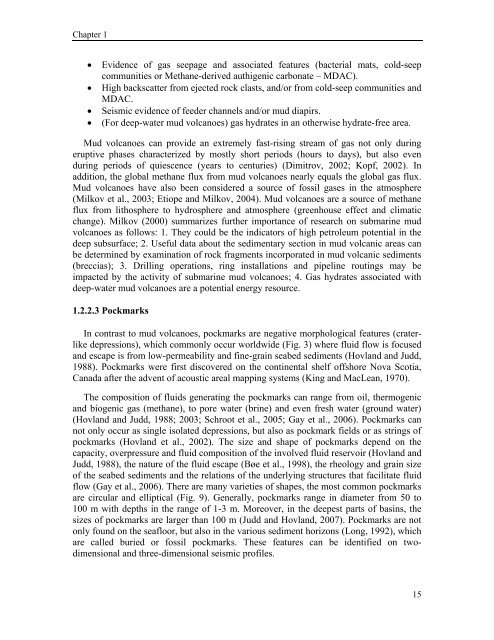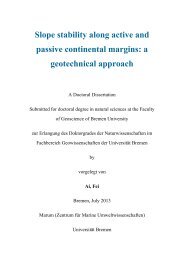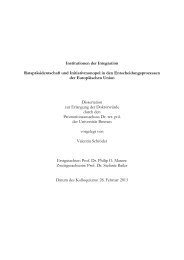Seismoacoustic Study of the Shallow Gas Transport and ... - E-LIB
Seismoacoustic Study of the Shallow Gas Transport and ... - E-LIB
Seismoacoustic Study of the Shallow Gas Transport and ... - E-LIB
You also want an ePaper? Increase the reach of your titles
YUMPU automatically turns print PDFs into web optimized ePapers that Google loves.
Chapter 1<br />
Evidence <strong>of</strong> gas seepage <strong>and</strong> associated features (bacterial mats, cold-seep<br />
communities or Methane-derived authigenic carbonate – MDAC).<br />
High backscatter from ejected rock clasts, <strong>and</strong>/or from cold-seep communities <strong>and</strong><br />
MDAC.<br />
Seismic evidence <strong>of</strong> feeder channels <strong>and</strong>/or mud diapirs.<br />
(For deep-water mud volcanoes) gas hydrates in an o<strong>the</strong>rwise hydrate-free area.<br />
Mud volcanoes can provide an extremely fast-rising stream <strong>of</strong> gas not only during<br />
eruptive phases characterized by mostly short periods (hours to days), but also even<br />
during periods <strong>of</strong> quiescence (years to centuries) (Dimitrov, 2002; Kopf, 2002). In<br />
addition, <strong>the</strong> global methane flux from mud volcanoes nearly equals <strong>the</strong> global gas flux.<br />
Mud volcanoes have also been considered a source <strong>of</strong> fossil gases in <strong>the</strong> atmosphere<br />
(Milkov et al., 2003; Etiope <strong>and</strong> Milkov, 2004). Mud volcanoes are a source <strong>of</strong> methane<br />
flux from lithosphere to hydrosphere <strong>and</strong> atmosphere (greenhouse effect <strong>and</strong> climatic<br />
change). Milkov (2000) summarizes fur<strong>the</strong>r importance <strong>of</strong> research on submarine mud<br />
volcanoes as follows: 1. They could be <strong>the</strong> indicators <strong>of</strong> high petroleum potential in <strong>the</strong><br />
deep subsurface; 2. Useful data about <strong>the</strong> sedimentary section in mud volcanic areas can<br />
be determined by examination <strong>of</strong> rock fragments incorporated in mud volcanic sediments<br />
(breccias); 3. Drilling operations, ring installations <strong>and</strong> pipeline routings may be<br />
impacted by <strong>the</strong> activity <strong>of</strong> submarine mud volcanoes; 4. <strong>Gas</strong> hydrates associated with<br />
deep-water mud volcanoes are a potential energy resource.<br />
1.2.2.3 Pockmarks<br />
In contrast to mud volcanoes, pockmarks are negative morphological features (craterlike<br />
depressions), which commonly occur worldwide (Fig. 3) where fluid flow is focused<br />
<strong>and</strong> escape is from low-permeability <strong>and</strong> fine-grain seabed sediments (Hovl<strong>and</strong> <strong>and</strong> Judd,<br />
1988). Pockmarks were first discovered on <strong>the</strong> continental shelf <strong>of</strong>fshore Nova Scotia,<br />
Canada after <strong>the</strong> advent <strong>of</strong> acoustic areal mapping systems (King <strong>and</strong> MacLean, 1970).<br />
The composition <strong>of</strong> fluids generating <strong>the</strong> pockmarks can range from oil, <strong>the</strong>rmogenic<br />
<strong>and</strong> biogenic gas (methane), to pore water (brine) <strong>and</strong> even fresh water (ground water)<br />
(Hovl<strong>and</strong> <strong>and</strong> Judd, 1988; 2003; Schroot et al., 2005; Gay et al., 2006). Pockmarks can<br />
not only occur as single isolated depressions, but also as pockmark fields or as strings <strong>of</strong><br />
pockmarks (Hovl<strong>and</strong> et al., 2002). The size <strong>and</strong> shape <strong>of</strong> pockmarks depend on <strong>the</strong><br />
capacity, overpressure <strong>and</strong> fluid composition <strong>of</strong> <strong>the</strong> involved fluid reservoir (Hovl<strong>and</strong> <strong>and</strong><br />
Judd, 1988), <strong>the</strong> nature <strong>of</strong> <strong>the</strong> fluid escape (Bøe et al., 1998), <strong>the</strong> rheology <strong>and</strong> grain size<br />
<strong>of</strong> <strong>the</strong> seabed sediments <strong>and</strong> <strong>the</strong> relations <strong>of</strong> <strong>the</strong> underlying structures that facilitate fluid<br />
flow (Gay et al., 2006). There are many varieties <strong>of</strong> shapes, <strong>the</strong> most common pockmarks<br />
are circular <strong>and</strong> elliptical (Fig. 9). Generally, pockmarks range in diameter from 50 to<br />
100 m with depths in <strong>the</strong> range <strong>of</strong> 1-3 m. Moreover, in <strong>the</strong> deepest parts <strong>of</strong> basins, <strong>the</strong><br />
sizes <strong>of</strong> pockmarks are larger than 100 m (Judd <strong>and</strong> Hovl<strong>and</strong>, 2007). Pockmarks are not<br />
only found on <strong>the</strong> seafloor, but also in <strong>the</strong> various sediment horizons (Long, 1992), which<br />
are called buried or fossil pockmarks. These features can be identified on twodimensional<br />
<strong>and</strong> three-dimensional seismic pr<strong>of</strong>iles.<br />
15
















